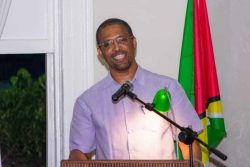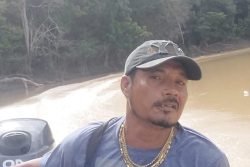A very significant factor in Carifesta is literature. A meaningful study of this regional cultural festival is a lengthy and complex undertaking that will require many revisits, including its treatment and representation of the region’s literature.
 It is not unusual that an institution such as a university library would have an interest in this and would have actually played an active and important role.
It is not unusual that an institution such as a university library would have an interest in this and would have actually played an active and important role.
Literature in Carifesta was high on its very first agenda. A role in highlighting, advancing, exhibiting, encouraging and even generating new contemporary literature in the Caribbean was a strict mandate given to the Caribbean Festival of the Arts when it was outlined in detail at a conference of artists in Georgetown, Guyana in February 1970.
The brief background is that the Government of Guyana invited many of the Caribbean’s foremost writers, musicians, dramatists, visual artists, theatre people and cultural icons to a meeting in Georgetown in 1966 where many plans were made. Nothing came of them; a second conference was called in 1970 in order to reignite – to have another “visitation . . . to whet [their] almost blunted purpose” (Hamlet). This was a larger and more important meeting where the actual details of the first Carifesta were committed to ink. Interestingly, the earliest attempts at regional cooperation in the arts may date back to events in 1953 (in London) and 1958 (Port-of-Spain), but in 1970 (Georgetown), a festival was founded in full.
 Among the many commitments was a mandate to collect, present and publish West Indian literature. It was specified that there should be exhibitions and publications that should reflect the multilingual nature of the region, since French, Dutch and Spanish-speaking territories were included and invited to Carifesta. Each Carifesta was mandated to have a publication of this collected literature in order to keep pace with the continuing series of new emerging work. This promise was never fulfilled. There have only been four such volumes from 1972 to 2017.
Among the many commitments was a mandate to collect, present and publish West Indian literature. It was specified that there should be exhibitions and publications that should reflect the multilingual nature of the region, since French, Dutch and Spanish-speaking territories were included and invited to Carifesta. Each Carifesta was mandated to have a publication of this collected literature in order to keep pace with the continuing series of new emerging work. This promise was never fulfilled. There have only been four such volumes from 1972 to 2017.
A J Seymour, who was present at the two meetings and knew what was intended, edited the first volume in 1972. This was New Writing From the Caribbean, the only collection that did all that was asked for in the meetings. It includes pieces of poetry and prose by many writers of the time from a range of countries including Suriname and other non-English-speaking territories. Many of them actually took part, reading their work in Carifesta. The fourth volume was again done in Guyana – collected by Petamber Persaud for Carifesta X in 2008. It is a much smaller publication containing poems sent in from different West Indian territories, but it did not reflect poets who were actually at Carifesta, nor represent the contemporary state of the literature.
The second and third both came out of Carifesta II in Jamaica. These were substantial and important publications; the intention was to publish one each of prose, poetry and drama. A volume of prose titled Forum (1976) was edited by Jamaican novelist John Hearne and it does show something of the preoccupations and can stand as a record of the time.
The second is A Time and A Season (1976) edited by Trinidadian playwright Errol Hill. It collected a number of plays including from non-English-speaking countries, to make available significant Caribbean drama of that period, mainly never before published in print and not available elsewhere. Examples are the only known play by poet and novelist Ian McDonald, The Tramping Man (originally written in 1966), and The Banjo Man by Roderick Walcott of St Lucia. Banjo Man is a dramatisation of the La Rose tradition and an important document of the region’s theatre captured at that time.
It is said that the road to hell is paved with good intentions, and truly, so it is with the pock-marked highway running through the 45 years and 13 Carifestas since 1972. There are no other festival publications outside of those four despite several promises. This is in spite of the exceedingly rich outpouring of literature over that period, much of which was actually presented and/or represented at many of the festivals. This included the presence of writers who read and discussed their work and the several panels, papers and analyses by critics and academics at Carifesta Symposia.
The Barbadian Symposium Coordinator of 2017, Marcia Burrowes has announced the intention to publish, and one has to give her time and a fair chance to avoid further contributions to surfacing the road to hell.
Overall, there has been a definite waning of the representation of literature in Carifesta. In accordance with the wishes of those who founded the festival, it was possible to keep in touch with current and new literature from around the region by attending events at Carifesta. This was certainly the case in Jamaica in 1976 and in Trinidad in 1992 and 1995. Several of the foremost writers of West Indian literature attended as representatives of their countries or as special invitees of the host countries to read from their work and engage in discussions.
Additionally, oral performances of literature by leading personalities in the field were regular features at Carifesta. Outstanding among these were Paul Keens Douglas and Robin Dobru. Keens Douglas of Trinidad was the most popular in performance monologues and comedy, later in stand-up comedy, while Dobru of Suriname was another drawing card because of the performance quality of his poems recited at Carifesta.
Furthermore, up to 1995 there were symposia in which the most prominent critics and academics presented panels on a range of subjects relevant to West Indian literature. “Exile” in Jamaica, for instance, was a burning topic which featured Guyana’s Martin Carter, famous for choosing never to join the bulk of leading writers in “exile” in the UK, Canada or the USA. Such high-powered treatment of literature has been rare in Carifesta since 1995.
That kind of background has made the recent inputs from the University of Guyana (UG), its library, and the Guyana Prize for Literature all the more important and effective in Carifesta.
Decidedly, the most impressive and meaningful literary input from any country at Carifesta XIII in Barbados 2017 was the grand exhibition of Guyanese literature mounted by the UG Library in collaboration with the Guyana Prize. This spectacular display of books, photographs and biographies had the following components: (1) An exhibition of Guyanese literature; (2) the Guyana Prize exhibition; (3) the Guyana Classics; and (4) A booklet/catalogue of the exhibition.
It was a project with the overall supervision of UG Librarian Gwyneth George along with the work of the secretariat of the Guyana Prize. The booklet/catalogue is a substantial piece of work, which was edited by Mrs George and Alim Hosein, a Senior Lecturer of UG. It documents the entire content of the exhibition. Additionally, it records all the winners of the Guyana Prize from 1987 to 2014, and of the Guyana Prize Caribbean Award from 2010 to 2014. Besides, it lists all the works shortlisted for the prizes over those same periods.
There is a display of prominent Guyanese writers with photographs and biographical information which makes quite spectacular tableaux. The Guyana Prize Exhibition that complements this contains all the winning books and shortlisted works in the prize since 1987 along with pictures and profiles of the authors. The Guyana Classics are works reprinted by the Caribbean Press. These classics are selected titles considered important to Guyanese literature, not only creative writing but historical and other non-fiction works which might have been out of print or not accessible. The collection makes them available to readers and to schools around the country; these were also on show with the exhibition at Carifesta.
The impact of this display was emphatic. Large numbers of visitors were impressed by the exhibits and attracted by the visual effect. Members of the UG Library staff Karen Roberts-Luke and Nirmala Kissoon who supervised the exhibition in Barbados reported a range of interesting responses by the multitudes of visitors to the site. There were daily enquiries about whether the books were on sale and how they could buy copies. A good human-interest story was that of Guyanese novelist Denise Harris who lives in Barbados. She is a winner of the Best First Book Prize and was over-thrilled to see her photograph and her book, as well as those of her father Wilson Harris, prominently on show when she visited Carifesta. The attendant librarians had to answer a daily suite of questions about the Guyana Prize, the Caribbean Prize and about various Guyanese writers.
This exhibition was therefore a unique experience added to Carifesta and certainly spoke eloquently about the literature of a nation to persons visiting the festival. It fulfilled quite a bit of the intentions and expectations of the treatment of Caribbean literature in Carifesta in a way that has perhaps been lacking for most of the history of the festival. It illustrated just how seriously Guyana as a whole took Carifesta and the special effort made to present literature unlike so many other countries.
It is true that in Barbados in 2017 there was a return to a concentration of literary presentations in the symposia that had fallen away since 1995, (except for Carifesta X in Guyana 2008). There were a few important literary events such as the launch of books by very important and prominent writers: Leviticus by Edward Kamau Brathwaite, The Art of Death by Edwidge Danticat that fuelled extensive discussions and Peelin Orange by Mervyn Morris.
These gave a reminder of the distinguished presence of major writers that had faded away in 1995, and certainly not seen again since Derek Walcott participated along with David Dabydeen, Edward Baugh, Earl Lovelace, Rex Nettleford and Austin Clarke in 2008 in Guyana.
The founders of Carifesta had hoped for that kind of richness arising from major writers in attendance, but aside from 2008, the festival has been failing to deliver over the last 22 years. The grand exhibition by the UG Library and the Guyana Prize therefore went a very long way in filling that vacuum.









